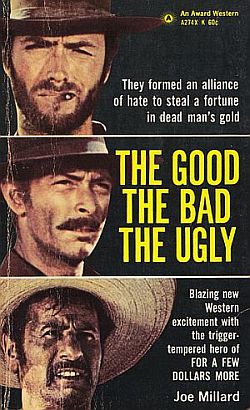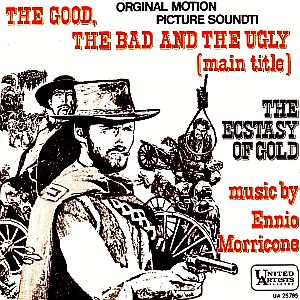
United Artists record sleeve for a 1968 Netherlands edition of two singles from “The Good, The Bad & The Ugly,” featuring title track and “The Ecstasy of Gold”.
Music Player
“The Ecstasy of Gold”
1966-67 – Ennio Morricone
Over the last 50 years, the song has become something of a classic, used on various occasions for its stirring, rising tempo and triumphant and uplifting energy – from Metallica concerts and sporting events to mainstream TV advertising. “The Ecstasy of Gold” is among Morricone’s most famous compositions, and its performance is aided by the amazing voice of Edda Dell’Orso, who is featured in the song’s stirring vocal high notes.
The song is played during a famous scene in the film when Tuco – “the ugly” character, played perfectly by Eli Wallach – is frantically searching through a huge Civil War-era graveyard for the name of a gravesite that is said to hold a fortune in gold treasure. Tuco is “ecstatic” to be at the cemetery where the gold is hidden, thus the name of the tune. But actually finding the gravesite where the gold is buried is another story. This “frantic search” scene by Tuco precedes a final climactic standoff and shoot-out when the three main characters in the story converge on the site and vie for the gold. But it is the “Ecstacy of Gold” song, and also the film’s title song, that have had continuing appeal over the years. The film itself has also become something of a classic in the Western genre.

In the film, “The Good, The Bad & The Ugly,” Elli Wallach’s “Tuco” character, has just arrived at the Sad Hill Cemetery, with thousands of Civil War graves, one of which holds hidden gold, which Tuco frantically searches for while Ennio Morricone’s “Ecstasy of Gold” plays in the film’s soundtrack.
In the film, following Tuco’s initial excitement, there comes the climactic showdown scene at the cemetery’s circular plaza (seen in the distance, above photo), when the three main characters appear in a three-way Mexican stand-off and gun battle out over the gold treasure. In that scene, “Blondie,” the “good” character, played by Clint Eastwood, and “Angel Eyes,” the “bad” character, played by Lee Van Cleef, face off, along with Tuco, to determine who will survive to get the gold. More on that outcome and the film’s music a bit later. First, some background on the film’s history and its storyline.
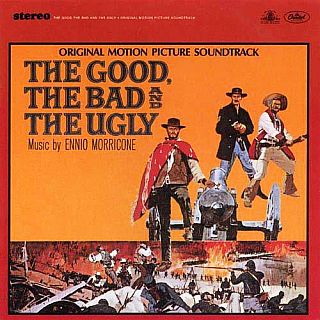
The original soundtrack for “The Good, The Bad & The Ugly,” with added tracks. Click for CD or digital singles.
After first being released in Italy in 1966, the three films were then each released in the U.S. in sequence during 1967 — A Fistful of Dollars in January 1967; For a Few Dollars More in May 1967, and The Good, The Bad & The Ugly at the end of December 1967. Given the bad rap of the spaghetti westerns at the time, the critical reception of the films following their release was mixed, but in later years they gained critical acclaim. The Good, The Bad & The Ugly was a financial success in its day, grossing over $25 million at the box office, and is credited with sending Clint Eastwood into stardom.
Plot & Characters

Clint Eastwood as “Blondie,” the nickname his sometimes partner, Tuco, has given him. Of the three, he is the only one who has any semblance of empathy.
In the early part of the film, Tuco and Blondie are running a bandit-reward scam with local law enforcement. Tuco, a Mexican bandit, is wanted for a long list of crimes, and bounty hunter Blondie turns him in to local officials for a reward, which he then splits with Tuco after helping Tuco escape execution – a lucrative money-making scam repeated by the pair in a couple of small towns. But Blondie becomes fed up with Tuco’s complaints, and abandons him in the desert. Tuco survives, vows vengeance, and tracks Blondie down in a town where Tuco has captured Blondie and placed him on a precarious perch to hang himself. But Union shelling there creates enough confusion and opportunity for Blondie to escape.
Tuco later recaptures Blondie and marches him across a desert until Blondie collapses from dehydration. Tuco by this point is ready to shoot Blondie and be done with him, but just then, a runaway stagecoach appears – a Confederate stagecoach with dead and dying soldiers inside, one of whom is Bill Carson, who knows about buried Confederate gold. He promises Tuco $200,000, money which is buried in a grave in the Sad Hill Cemetery. Tuco presses the dying Carson for the name of the grave, but Carson needs water, and passes out from thirst. Tuco then rushes off to fetch water for Carson, but Blondie, also near death by this time given his desert torture by Tuco, is slumped next to the dying Carson. When Tuco returns with water, Carson has died and Blondie reveals that Carson whispered the name on the grave marker to him just before dying. Tuco, whose moral compass is opportunist at all times, immediately turns his attention to reviving and caring for Blondie, now his “best friend” again. Tuco lavishes him with water and care, taking him to a nearby frontier mission to recover, where Tuco’s brother happens to be the head Abbot.
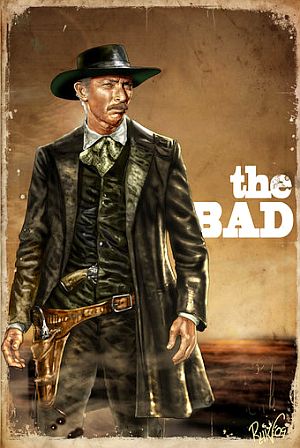
Actor Lee Van Cleef plays “Angel Eyes” – “the Bad” character in “The Good, The Bad & The Ugly” film.
Played by Lee Van Cleef, Angel Eyes is a ruthless killer who has also heard about the Confederate gold, but doesn’t know the details. He is now disguised as a Union sergeant at the Yankee prisoner camp and tortures Tuco, who reveals the name of the cemetery, but not the name on the grave, which only Blondie knows.
Knowing that Blondie will not likely give up the gravesite name, Angel Eyes offers him an equal share of the gold, and the two ride out as Tuco is put on a prisoner train to be executed, but later escapes. Blondie, Angel Eyes, and his gang arrive in an evacuated, war-contested town, where Tuco has come as well. There, afer a gunfight with others, Tuco resumes a partnership with Blondie, and the pair turn their guns on Angel Eyes’s gang, killing most of them. Angel Eyes, however, has escaped.
Tuco and Blondie continue to make their way to Sad Hill Cemetery (which only Tuco knows at this point), but they are blocked by large Union and Confederate forces preparing for battle. The two armies are separated only by a narrow bridge. Each side is preparing to fight for it, but apparently both sides have been ordered not to destroy the bridge. However, Blondie, reasoning that if the bridge were destroyed “these idiots would go somewhere else to fight.” So he and Tuco then set out to wire the bridge with dynamite.
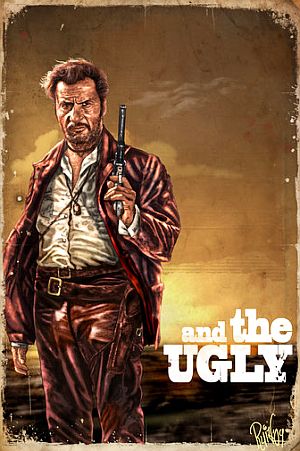
Actor Eli Wallach plays “Tuco” – “the Ugly” character, in “The Good, The Bad & The Ugly” film.
Music Player
“The Death of a Soldier”
Tuco, meanwhile, has left Blondie and is making his way to the cemetery to retrieve the gold for himself. When he arrives, he is beset by a very large cemetery stretching out in all directions, holding hundreds if not thousands of graves. It is here where Tuco begins running and spinning in something of a whirling frenzy, searching for the gravesite with Arch Stanton’s name. And this is when “The Ecstasy of Gold” song runs at full throttle, reflecting Tuco’s feverish search.
Running through the sea of tombstones and makeshift grave markers, Tuco finally locates Arch Stanton’s grave. As he digs with his hands, Blondie suddenly appears. Clad in his trademark poncho, and chomping on a slender cheroot-type Toscano cigar, he tosses a shovel to Tuco. A few moments later, the two are surprised by Angel Eyes, who holds them both at gunpoint. Blondie kicks open Stanton’s grave to reveal it holds no gold, just a skeleton. He hadn’t given up the real name afterall. Declaring that only he knows the name of the grave with the gold, Blondie writes the name on a rock and places it in the middle of the cemetery, telling Tuco and Angel Eyes that “two hundred thousand dollars is a lot of money. We’re going to have to earn it” — meaning, fight for it.

Long view of the climactic Mexican standoff scene at the Sad Hill Cemetery plaza, where Blondie, Angel Eyes, and Tuco take up positions for a gun fight to determine who will survive to get the gold.
The three then warily back off from one another and take positions nearly equally separated around the outer circumference of a stone plaza at the center of the cemetery. They stare each other down in a Mexican standoff. The camera pans back-and-forth with close-ups of each of their faces, one by one. On the soundtrack, guitar strings sound, countdown-like, with the “Triple Duel” song building the tension. Then, they go for their guns and the shooting ensues.
Blondie shoots Angel Eyes, who tries to shoot Blondie as he falls, only to be shot again by Blondie, then rolling into an open grave. Angel Eyes is dead. Tuco also tries to shoot Angel Eyes, but discovers that Blondie had unloaded his gun the night before.
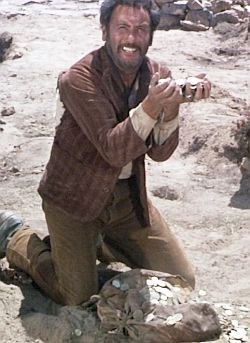
Tuco is overjoyed at finding the gold.
But Blondie has a surprise for Tuco.
Seeking revenge for what Tuco had done to him earlier in the desert, Blondie forces Tuco to stand atop a shaky grave marker, hands bound behind him, while he places a noose around Tuco’s neck tied to a tree branch above.
Blondie is now prepared to ride off, having collected his share of the gold – but only his share – leaving Tuco’s share there on the ground below, as Tuco now deals with his shaky predicament.
As Blondie rides away, Tuco screams for mercy, but Blodie continues his ride. Then the camera pans to Blondie’s silhouette on horseback, seen on a distant hillside against the horizon. He is aiming his rifle at Tuco. Blondie fires a single shot and severs the rope of the noose around Tuco’s neck, as he had done on several previous occasions when he and Tuco were running their local bandit-reward scams.
As the lynch rope is severed by Blondie’s rifle shot, Tuco falls face-first onto the ground below and on top of his share of the gold. Blondie smiles and rides off. Tuco, meanwhile, now has his gold, but his hands are still bound and he has no horse. In a rage of shouting he begins cursing Blondie with a string of expletives. “Hey Blondie! You know what you are? Just a dirty ….” And with that, the film ends.

Near the end of “The Good, The Bad & The Ugly,” Blondie takes revenge on Tuco for his earlier near-death desert torture of Blondie, who now --planning to ride off -- has Tuco set precariously atop a shaky gravemarker rigged to a lynch rope.
Music Lives On

Hugo Montenegro album featuring covers of several Ennio Morricone songs from Sergio Leone westerns. Click for CD.
The main theme song from that soundtrack — using whistling and other sound effects, which some say resemble a coyote in parts — would become especially memorable.
The theme’s motif runs through the soundtrack in various forms, and is also cleverly adapted as identity music for each of the three main characters using separate musical instruments – flute for Blondie, ocarina for Angel Eyes, and human voices for Tuco.
In fact, largely on the strength of the title track, the Morricone soundtrack album remained on the music charts for more than a year, rising to No. 4 on the Billboard albums chart and No. 10 on the R&B albums chart.
In August 1968, the original score was certified by the RIAA with a gold record for the sale of 500,000 copies in the U. S. alone. Worldwide, it sold more than three million copies, earning more than $20 million for Morricone since its release.
The main theme was also a hit for American musician, Hugo Montenegro, whose rendition was a No. 2 Billboard single in 1968. Montenegro’s album of that year, featuring “The Good, The Bad & The Ugly” theme, also included additional Morricone songs from other Sergio Leone films.
In 2001, a European production of the Morricone soundtrack was released by GDM music with additional tracks. In 2004, the original soundtrack album was remastered and re-released on Capitol Records, with 10 additional tracks from the film. And in 2009, The Recording Academy inducted Morricone’s 1966 score for The Good, The Bad & The Ugly into the Grammy Hall of Fame.“The Ecstasy of Gold,” meanwhile, has been used in a number of films, TV shows, video games, and TV ads. The heavy metal rock band, Metallica, has taken a special interest in the song. For more than two decades, since 1985, Metallica has used the song, in its classic rendition, to open their live shows. As the music plays, the band members usually take the stage. The band has also recorded a cover version of the song, and that version appears on several Metallica albums, including a version they recorded with the San Francisco Symphony Orchestra for their S&M album.
The Ramones rock group has also used the song on albums and in performances, as has classical musician, Yo-Yo Ma. On American radio, “The Opie & Anthony Show” (1995-2014), used “The Ecstasy of Gold” as opening music. Jay Z and rapper Immortal Technique are among those who have sampled the song, and it has been remixed by Bandini for the Ennio Morricone Remixes 2 album of 2004. “The Ecstasy of Gold” is also played as entrance music at every home game of Los Angeles Football Club (soccer).
Other stories at this website exploring the power and influence of music in film include: “Streets of Philadelphia” (Bruce Springsteen and Neil Young songs in Philadelphia, with Tom Hanks as AIDS victim Andy Beckett); “The Saddest Song” (Samuel Barber’s “Adagio for Strings” in Platoon and other films); “You Only Live Twice: Film & Music, 1967” (a James Bond film story by that name and main theme song by Nancy Sinatra); “Let The River Run” (Carly Simon’s hit song from 1988’s Working Girl); and “Philadelphia Morning – Rocky Music: 1976-1977”. See also the “Film & Hollywood” page for additional stories in that category.
Thanks for visiting – and if you like what you find here, please make a donation to help support the research and writing at this website. Thank you. – Jack Doyle
|
Please Support Thank You |
____________________________________
Date Posted: 28 October 2019
Last Update: 28 October 2019
Comments to: jdoyle@pophistorydig.com
Article Citation:
Jack Doyle, “The Ecstasy of Gold: 1966-2010s,”
PopHistoryDig.com, October 28, 2019.
____________________________________
Sources, Links & Additional Information
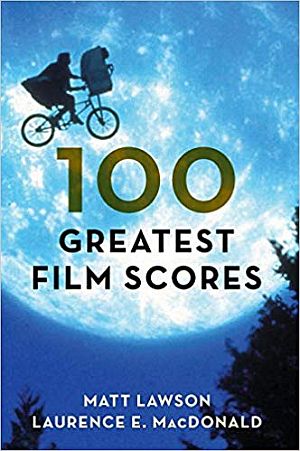
Matt Lawson & Laurence MacDonald’s 2018 book, “100 Greatest Film Scores,” Rowman & Littlefield Publishers, 336pp. Click for copy.
“The Good, the Bad and the Ugly (1966),” IMDB .com.
“The Good, The Bad, and The Ugly,” Wikipedia .org.
Roger Ebert, “Great Movie: The Good, The Bad & The Ugly,” RogerEbert.com, August 3, 2003.
“9. The Death Of A Soldier – Ennio Morricone (The Good, The Bad And The Ugly),” YouTube .com, Posted by Art Revell, December 17, 2012 (with posted comments).
Matthew Jackson, “12 Great Facts About The Good, The Bad and The Ugly,” MentalFloss.com, December 29, 2017.
“The Good, the Bad and the Ugly (soundtrack),” Wikipedia.org.
“The Good, the Bad and the Ugly (theme),” Wikipedia.org.
Charles Leinberger, Ennio Morricone’s The Good, the Bad and the Ugly: A Film Score Guide, September 1, 2004, Scarecrow Press, 160 pp.
“Ennio Morricone,” Wikipedia.org.
Nick Shave, “Drips, Pop and Dollars: The Music That Made Ennio Morricone,” TheGuardian.com, November 18, 2016.
Tim Gray, “Sergio Leone’s Spaghetti Westerns Made a Fistful of Dollars and Clint Eastwood a Star,” Variety.com, January 4, 2019.
_________________________________
